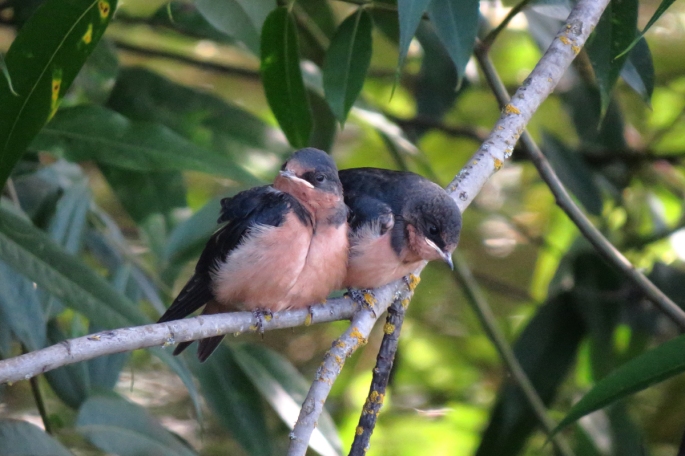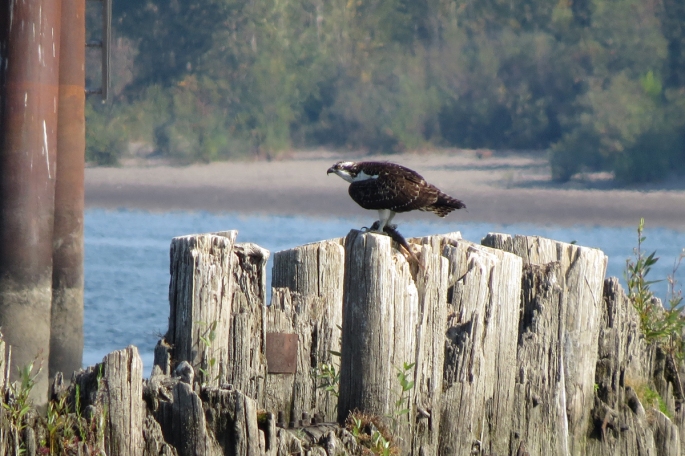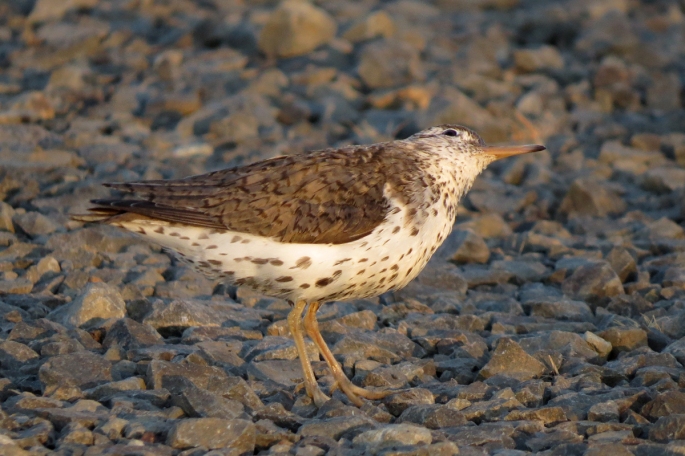I am not sure why the hottest days of mid-summer are referred to as “dog days.” My dogs want nothing to do with the heat, and the hot weather puts a damper on bird activity as well. Wetlands tend to be a little more active than woodlands this time of year, so here are some recent images from area wetlands.
 This Purple Martin is from the colony at Fernhill Wetlands. The recently installed nesting boxes there have been a great success.
This Purple Martin is from the colony at Fernhill Wetlands. The recently installed nesting boxes there have been a great success.
 Tree Swallows are everywhere. It is nice to find one perched on a stick instead of on a nest box.
Tree Swallows are everywhere. It is nice to find one perched on a stick instead of on a nest box.
 Ospreys on the nest at Jackson Bottom
Ospreys on the nest at Jackson Bottom
 This House Finch was feeding on green Elderberries at Smith and Bybee Wetlands.
This House Finch was feeding on green Elderberries at Smith and Bybee Wetlands.
 Spotted Towhee at Smith and Bybee
Spotted Towhee at Smith and Bybee
 Bewick’s Wrens seem to be very fond of dust baths this time of year.
Bewick’s Wrens seem to be very fond of dust baths this time of year.
 It is baby crow season. These youngsters were exploring the shallow waters of a slough at Smith and Bybee.
It is baby crow season. These youngsters were exploring the shallow waters of a slough at Smith and Bybee.
 It is harder to find herps in the hot weather. This Northwestern Garter was stuck in a vault for a water shut-off valve. I lifted him out and sent him on his way.
It is harder to find herps in the hot weather. This Northwestern Garter was stuck in a vault for a water shut-off valve. I lifted him out and sent him on his way.
 This is a very small, very thin Long-toed Salamander (note the insect parts nearby for scale).
This is a very small, very thin Long-toed Salamander (note the insect parts nearby for scale).
 Smith and Bybee Wetlands is thick with Green Herons right now. There were at least a dozen in this little slough.
Smith and Bybee Wetlands is thick with Green Herons right now. There were at least a dozen in this little slough.
 Shorebird migration is starting to pick up. Unfortunately, there is very little mudflat habitat in the Portland area right now. This Greater Yellowlegs was one of several sharing the slough with the Green Herons.
Shorebird migration is starting to pick up. Unfortunately, there is very little mudflat habitat in the Portland area right now. This Greater Yellowlegs was one of several sharing the slough with the Green Herons.
 Three Lesser Yellowlegs were also present at Smith and Bybee.
Three Lesser Yellowlegs were also present at Smith and Bybee.
 On the home front, we were treated to three baby Western Screech-Owls playing in the back yard. Two of them perched on the rope holding the sunshade and tried to untie the knots. It was almost too dark to see, so this is the best image I was able to get (6400 ISO). Pretty adorable.
On the home front, we were treated to three baby Western Screech-Owls playing in the back yard. Two of them perched on the rope holding the sunshade and tried to untie the knots. It was almost too dark to see, so this is the best image I was able to get (6400 ISO). Pretty adorable.
Happy Summer










 Belted Kingfisher on a very fancy perch
Belted Kingfisher on a very fancy perch Bonaparte’s Gull in first winter plumage
Bonaparte’s Gull in first winter plumage Gull Season is just around the corner.
Gull Season is just around the corner. juvenile White-crowned Sparrow
juvenile White-crowned Sparrow Green Heron with an American Bullfrog tadpole. It is nice when the native species eat the invasive ones. It is often the other way around.
Green Heron with an American Bullfrog tadpole. It is nice when the native species eat the invasive ones. It is often the other way around. This is an odd duck. It is a teal, probably Cinnamon, but is either leucistic or is going through a brutal molt.
This is an odd duck. It is a teal, probably Cinnamon, but is either leucistic or is going through a brutal molt. American White Pelicans are now common in the Portland area in late summer.
American White Pelicans are now common in the Portland area in late summer. American White Pelican coming in for a landing
American White Pelican coming in for a landing The first record of Black Phoebe in Washington County was in 2006 (by yours truly). Now they are rare but regular at both Jackson Bottom and Fernhill.
The first record of Black Phoebe in Washington County was in 2006 (by yours truly). Now they are rare but regular at both Jackson Bottom and Fernhill. Shorebird migration is in full swing. Numbers are better at the coast, but some birds are finding the small patches of mud at inland locations. This Least Sandpiper was feeding on some newly exposed mud at Jackson Bottom.
Shorebird migration is in full swing. Numbers are better at the coast, but some birds are finding the small patches of mud at inland locations. This Least Sandpiper was feeding on some newly exposed mud at Jackson Bottom. Here is the underside of a Lorquin’s Admiral. Those red eyes are intense.
Here is the underside of a Lorquin’s Admiral. Those red eyes are intense. Green Heron at Fernhill
Green Heron at Fernhill
 American White Pelican is another species that has become more common in the Portland area is recent years. They don’t nest here, but summer brings large numbers of young birds and post-breeding adults.
American White Pelican is another species that has become more common in the Portland area is recent years. They don’t nest here, but summer brings large numbers of young birds and post-breeding adults.






























































